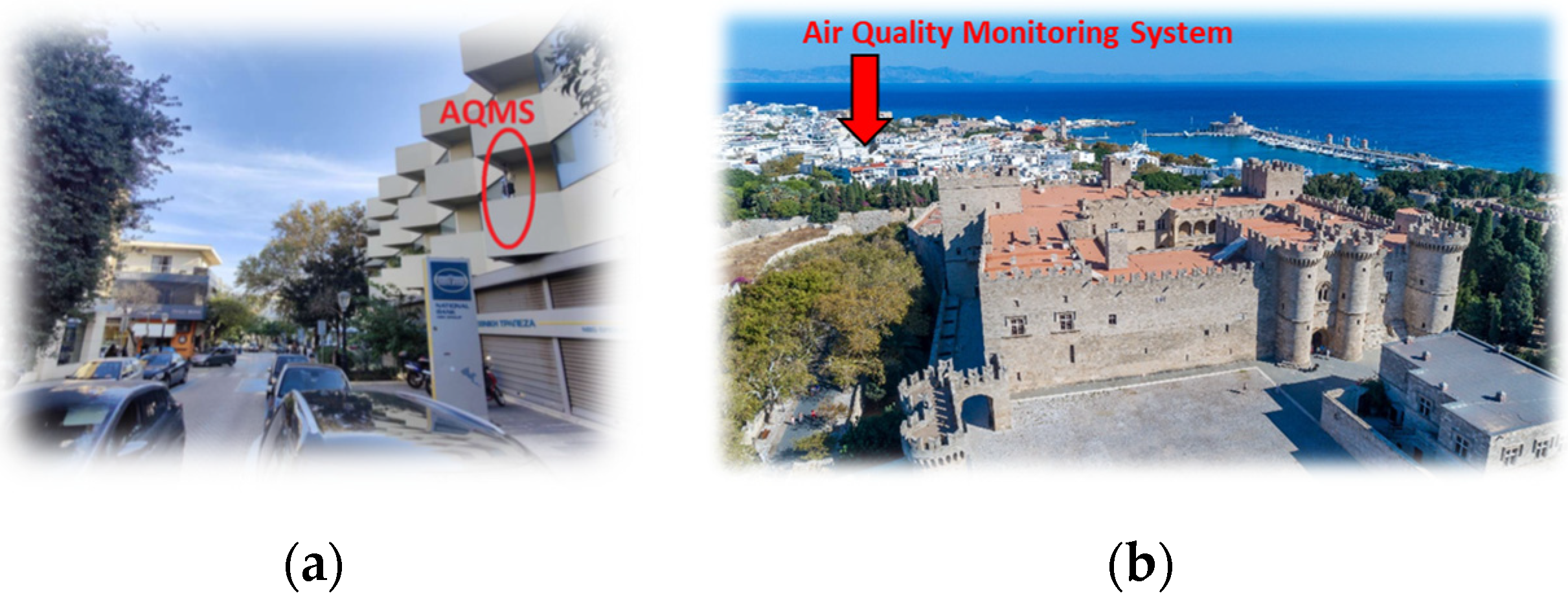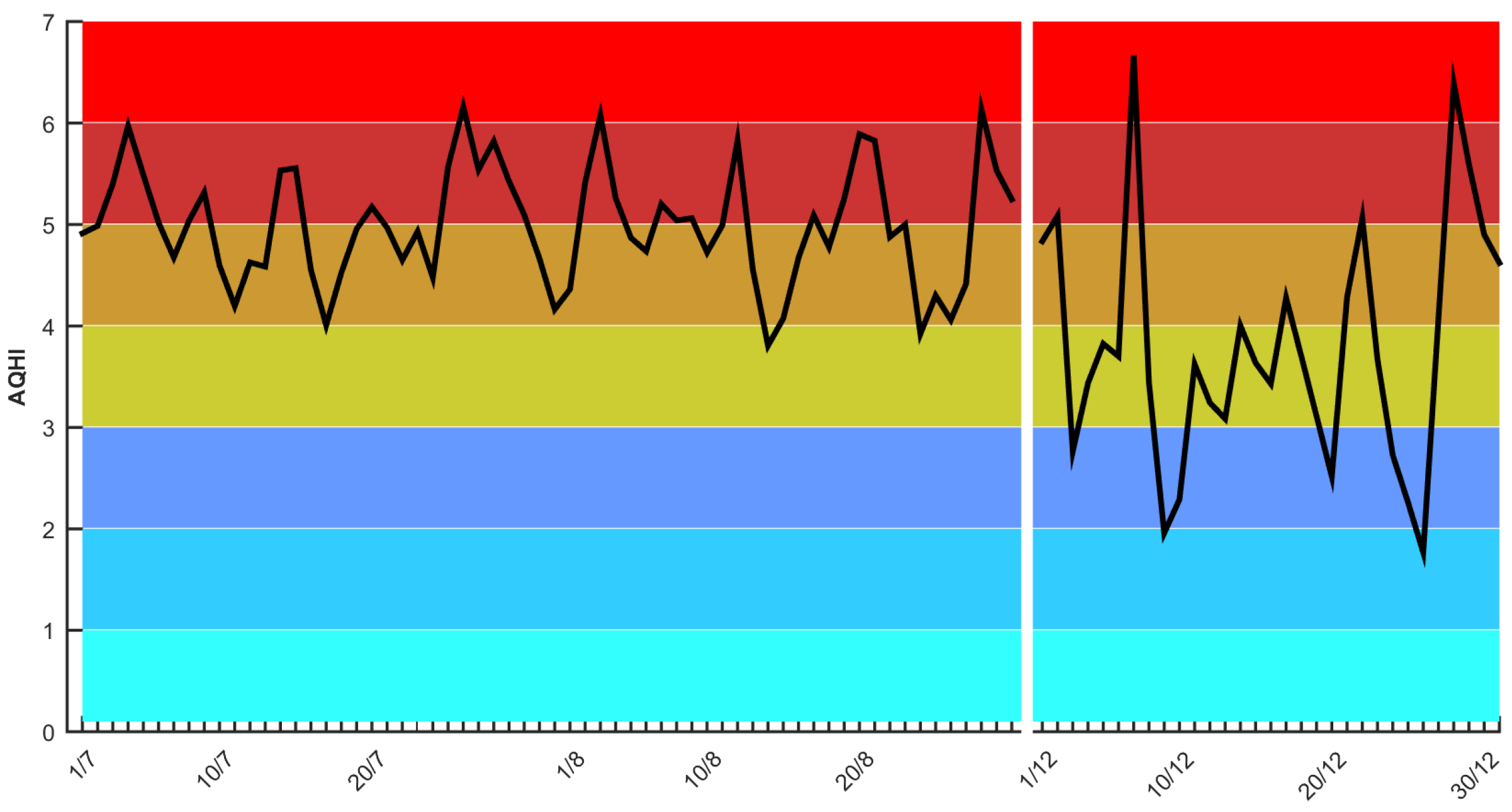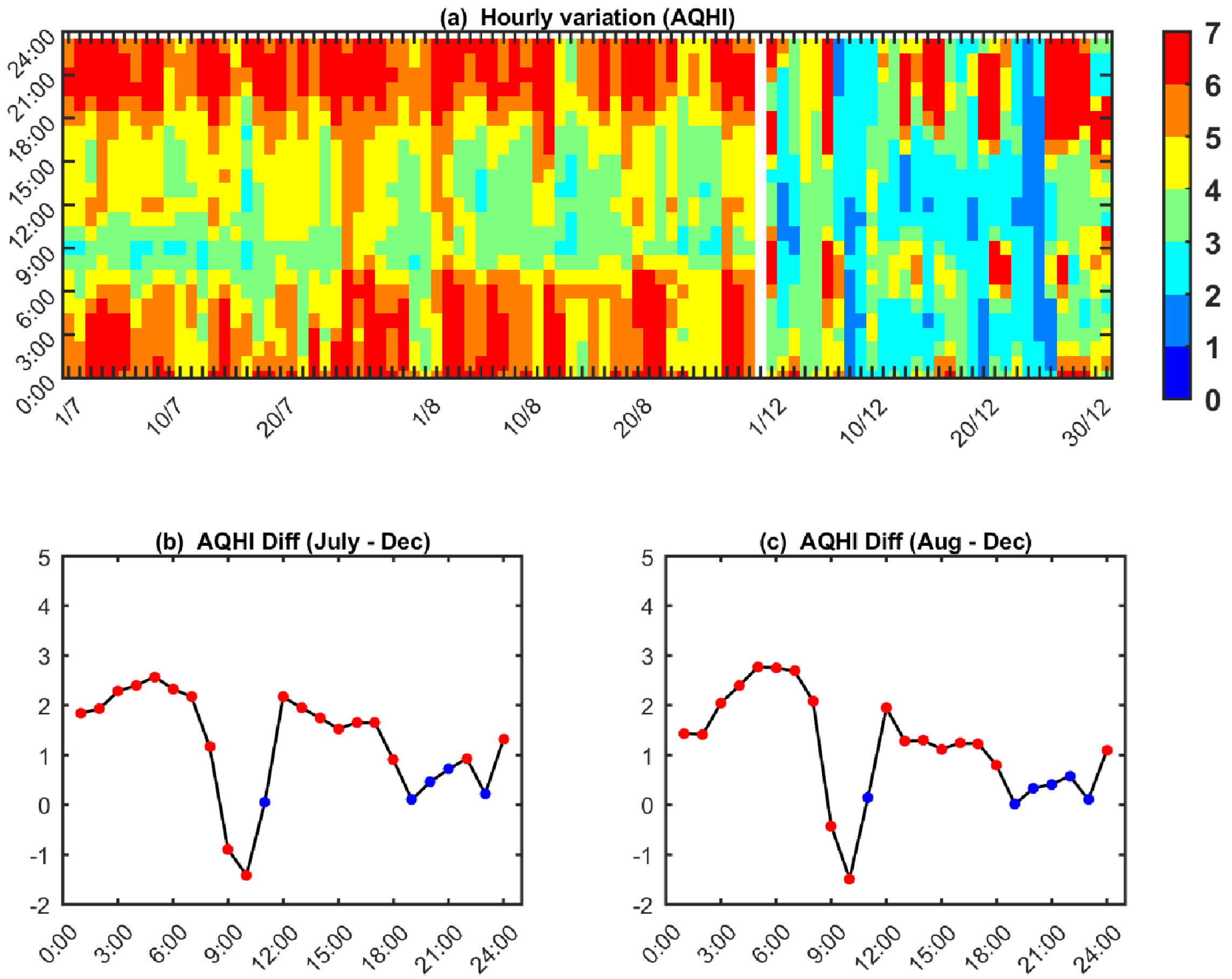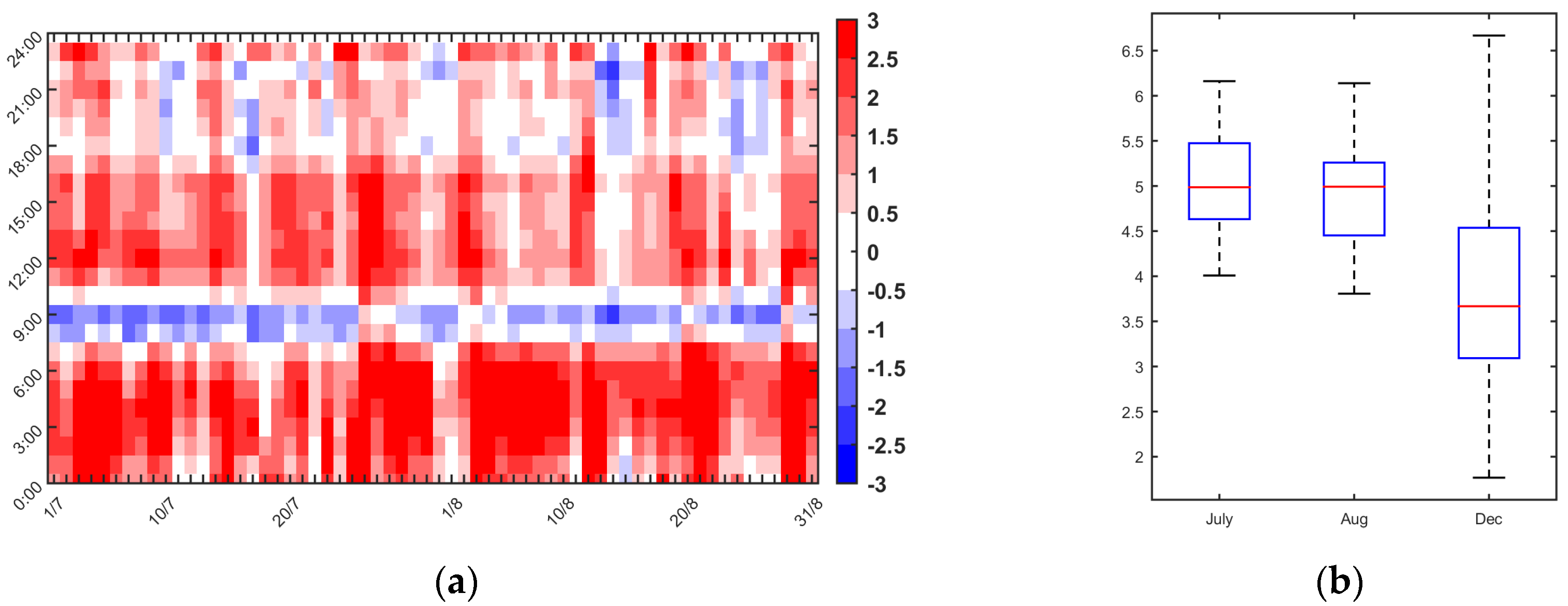Changes in Air Quality Health Index in a Coastal City of the Southeastern Aegean Sea between a Summer and Winter Period of 2022 †
Abstract
:1. Introduction
2. Materials and Methods
3. Results and Discussion
4. Conclusions
Author Contributions
Funding
Institutional Review Board Statement
Informed Consent Statement
Data Availability Statement
Acknowledgments
Conflicts of Interest
References
- World Health Organization. WHO Global Air Quality Guidelines: Particulate Matter (PM2.5 and PM10), Ozone, Nitrogen Dioxide, Sulfur Dioxide and Carbon Monoxide; World Health Organization: Geneva, Switzerland, 2021; Available online: https://apps.who.int/iris/handle/10665/345329 (accessed on 18 July 2023).
- McCarron, A.; Semple, S.; Braban, C.F.; Swanson, V.; Gillespie, C.; Price, H.D. Public engagement with air quality data: Using health behaviour change theory to support exposure-minimising behaviours. J. Expo. Sci. Environ. Epidemiol. 2023, 33, 321–331. [Google Scholar] [CrossRef] [PubMed]
- Nastos, P.T. Weather, Ambient Air Pollution and Bronchial Asthma in Athens, Greece. In Seasonal Forecasts, Climatic Change and Human Health; Thomson, M.C., GarciaHerrera, R., Beniston, M., Eds.; Advances in Global Change Research; Springer: Dordrecht, The Netherlands, 2008; Volume 30. [Google Scholar] [CrossRef]
- Monforte, P.; Ragusa, M.A. Evaluation of the air pollution in a Mediterranean region by the air quality index. Environ. Monit. Assess. 2018, 190, 625. [Google Scholar] [CrossRef] [PubMed]
- Logothetis, I.; Antonopoulou, C.; Zisopoulos, G.; Mitsotakis, A.; Grammelis, P. The Impact of Climate Conditions and Traffic Emissions on the Pms Variations in Rhodes City during the Summer of 2021. In Proceedings of the 7th World Congress on Civil, Structural, and Environmental Engineering, Virtual, 10–12 April 2022. [Google Scholar]
- Fameli, K.M.; Kotrikla, A.M.; Psanis, C.; Biskos, G.; Polydoropoulou, A. Estimation of the emissions by transport in two port cities of the northeastern Mediterranean, Greece. Environ. Pollut. 2020, 257, 113598. [Google Scholar] [CrossRef] [PubMed]
- Poupkou, A.; Nastos, P.; Melas, D.; Zerefos, C. Climatology of Discomfort Index and Air Quality Index in a Large Urban Mediterranean Agglomeration. Water Air Soil. Pollut. 2011, 222, 163–183. [Google Scholar] [CrossRef]
- Rizos, Κ.; Logothetis, Ι.; Koukouli, Μ.Ε.; Meleti, C.; Melas, D. The influence of the summer tropospheric circulation on the observed 221 ozone mixing ratios at a coastal site in the Eastern Mediterranean. Atmos. Pollut. Res. 2022, 13, 222. [Google Scholar] [CrossRef]
- OECD. Environmental Performance Reviews, Greece HIGHLIGHTS 2020. Available online: https://ypen.gov.gr/wp-content/uploads/2020/11/OECD-EPR-Greece-2020-Highlights-English.pdf (accessed on 31 March 2023).
- Yao, J.; Stieb, D.M.; Taylor, E.; Henderson, S.B. Assessment of the Air Quality Health Index (AQHI) and four alternate AQHI-Plus amendments for wildfire seasons in British Columbia. Can. J. Public. Health 2020, 111, 96–106. [Google Scholar] [CrossRef] [PubMed]
- Liang, L. Calibrating low-cost sensors for ambient air monitoring: Techniques, trends, and challenges. Environ. Res. 2021, 197, 111163. [Google Scholar] [CrossRef]
- Liu, H.Y.; Schneider, P.; Haugen, R.; Vogt, M. Performance assessment of a low-cost PM2.5 sensor for a near four-month period in Oslo, Norway. Atmosphere 2019, 10, 41. [Google Scholar] [CrossRef]
- deSouza, P.; Kahn, R.; Stockman, T.; Obermann, W.; Crawford, B.; Wang, A.; Crooks, J.; Li, J.; Kinney, P. Calibrating networks of low-cost air quality sensors. Atmos. Meas. Tech. 2022, 15, 6309–6328. [Google Scholar] [CrossRef]
- Achieng, G.O.; Andala, D.M. Determination of Ambient air quality status through Assessment of particulate matter and selected gases. In Proceedings of the International Conference on Air Quality in Africa (ICAQ’Africa2022), Online, 11–14 October 2022. [Google Scholar]
- EDC Environmental Device Corporation. Available online: https://environmentaldevices.com (accessed on 28 March 2023).
- Wilks, D.S. Forecast Verification. Statistical Methods in the Atmospheric Sciences; Academic Press: New York, NY, USA, 1995. [Google Scholar]
- Robaina, M.; Madaleno, M.; Silva, S.; Eusébio, C.; Carneiro, M.J.; Gama, C.; Oliveira, K.; Russo, M.A.; Monteiro, A. The relationship between tourism and air quality in five European countries. Econ. Anal. Policy 2020, 67, 261–272. [Google Scholar] [CrossRef]
- Kim, K.H.; Lee, S.-B.; Woo, S.H.; Bae, G.-N. NOx profile around a signalized intersection of busy roadway. Atmos. Environ. 2014, 637, 144–154. [Google Scholar] [CrossRef]
- Song, J.; Wang, Z.H.; Wang, C. Biospheric and anthropogenic contributors to atmospheric CO2 variability in a residential neighborhood of Phoenix, Arizona. J. Geophys. Res. Atmos. 2017, 122, 3317–3329. [Google Scholar] [CrossRef]
- Kim, K.H.; Lee, S.-B.; Woo, D.; Bae, G.-N. Influence of wind direction and speed on the transport of particle-bound PAHs in a roadway environment. Atmos. Pollut. Res. 2015, 6, 1024–1034. [Google Scholar] [CrossRef]
- Murthy, B.S.; Latha, R.; Tiwari, A.; Rathod, A.; Singh, S.; Beig, G. Impact of mixing layer height on air quality in winter. J. Atmos. Sol. -Terr. Phys. 2020, 197, 105157. [Google Scholar] [CrossRef]




| Health Risk | AQHI | Health Suggestions | |
|---|---|---|---|
| Sensitive Population | General Population | ||
| Low | 1–3 | Enjoy your usual outdoor activities. | Ideal air quality for outdoor activities. |
| Moderate | 4–6 | Consider reducing or rescheduling strenuous activities outdoors if you are experiencing symptoms. | No need to modify your usual outdoor activities unless you experience symptoms such as coughing and throat irritation. |
| High | 7–10 | Reduce or reschedule strenuous activities outdoors. Children and the elderly should also take it easy. | Consider reducing or rescheduling strenuous activities outdoors if you experience symptoms such as coughing and throat irritation. |
| Very High | >10 | Avoid strenuous activities outdoors. Children and the elderly should also avoid outdoor physical exertion. | Reduce or reschedule strenuous activities outdoors, especially if you experience symptoms such as coughing and throat irritation. |
Disclaimer/Publisher’s Note: The statements, opinions and data contained in all publications are solely those of the individual author(s) and contributor(s) and not of MDPI and/or the editor(s). MDPI and/or the editor(s) disclaim responsibility for any injury to people or property resulting from any ideas, methods, instructions or products referred to in the content. |
© 2023 by the authors. Licensee MDPI, Basel, Switzerland. This article is an open access article distributed under the terms and conditions of the Creative Commons Attribution (CC BY) license (https://creativecommons.org/licenses/by/4.0/).
Share and Cite
Logothetis, I.; Antonopoulou, C.; Zisopoulos, G.; Mitsotakis, A.; Grammelis, P. Changes in Air Quality Health Index in a Coastal City of the Southeastern Aegean Sea between a Summer and Winter Period of 2022. Environ. Sci. Proc. 2023, 27, 13. https://doi.org/10.3390/ecas2023-15128
Logothetis I, Antonopoulou C, Zisopoulos G, Mitsotakis A, Grammelis P. Changes in Air Quality Health Index in a Coastal City of the Southeastern Aegean Sea between a Summer and Winter Period of 2022. Environmental Sciences Proceedings. 2023; 27(1):13. https://doi.org/10.3390/ecas2023-15128
Chicago/Turabian StyleLogothetis, Ioannis, Christina Antonopoulou, Georgios Zisopoulos, Adamantios Mitsotakis, and Panagiotis Grammelis. 2023. "Changes in Air Quality Health Index in a Coastal City of the Southeastern Aegean Sea between a Summer and Winter Period of 2022" Environmental Sciences Proceedings 27, no. 1: 13. https://doi.org/10.3390/ecas2023-15128
APA StyleLogothetis, I., Antonopoulou, C., Zisopoulos, G., Mitsotakis, A., & Grammelis, P. (2023). Changes in Air Quality Health Index in a Coastal City of the Southeastern Aegean Sea between a Summer and Winter Period of 2022. Environmental Sciences Proceedings, 27(1), 13. https://doi.org/10.3390/ecas2023-15128








